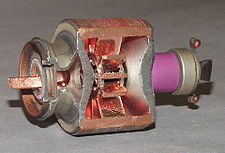Cavity magnetron
The cavity magnetron is a high-powered vacuum tube that makes microwaves using the interaction of a stream of electrons with a magnetic field. Electrons pass by holes (cavities), and the resonance creates microwaves, like blowing air on a flute creates sound (sound waves) of a certain pitch.[1] The 'resonant' cavity magnetron type of the earlier magnetron tube was invented by John Randall and Harry Boot in 1940.[2] The high power of pulses from the cavity magnetron made centimetre-band radar practical. Shorter wavelength radars allowed the finding of smaller objects. The small cavity magnetron tube made the size of radar sets much smaller[3] so that they could be put into in aircraft[4] and ships used to find submarines.[3] At present, cavity magnetrons are commonly used in microwave ovens and in various radar applications.[5]
Cavity Magnetron Media
Split-anode magnetron (c. 1935). (left) The bare tube, about 11 cm high. (right) Installed for use between the poles of a strong permanent magnet
A cross-sectional diagram of a resonant cavity magnetron. Magnetic lines of force are parallel to the geometric axis of this structure.
Cutaway drawing of a cavity magnetron of 1984. Part of the righthand magnet and copper anode block is cut away to show the cathode and cavities. This older magnetron uses two horseshoe shaped alnico magnets, modern tubes use rare-earth magnets.
Sir John Randall and Harry Boot's original cavity magnetron developed in 1940 at the University of Birmingham, England, now in the Science Museum, London.
References
- ↑ "How do magnetrons work?". Explain that Stuff. 28 August 2009. Retrieved 2020-05-20.
- ↑ "The Magnetron". Bournemouth University. 1995–2009. Retrieved 23 August 2009.
- ↑ 3.0 3.1 Schroter, B. (Spring 2008). "How important was Tizard's Box of Tricks?" (PDF). Imperial Engineer. 8: 10. Archived from the original (PDF) on 2011-06-17. Retrieved 2009-08-23.
- ↑ "Who Was Alan Dower Blumlein?". Dora Media Productions. 1999–2007. Archived from the original on 7 September 2009. Retrieved 23 August 2009.
- ↑ Ma, L. "3D Computer Modeling of Magnetrons Archived 2008-10-10 at the Wayback Machine." University of London Ph.D. Thesis. December 2004. Accessed 2009-08-23.

